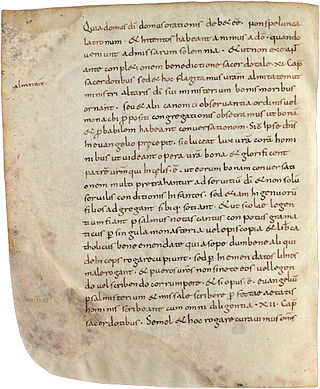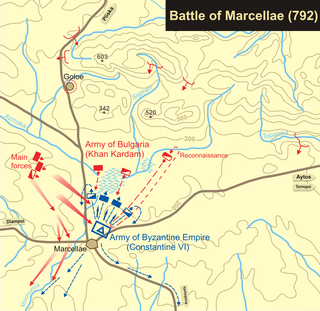The 800s decade ran from January 1, 800, to December 31, 809.
The 830s decade ran from January 1, 830, to December 31, 839.
The 790s decade ran from January 1, 790, to December 31, 799.
The 780s decade ran from January 1, 780, to December 31, 789.

Year 745 (DCCXLV) was a common year starting on Friday of the Julian calendar. The denomination 745 for this year has been used since the early medieval period, when the Anno Domini calendar era became the prevalent method in Europe for naming years.

Year 788 (DCCLXXXVIII) was a leap year starting on Tuesday of the Julian calendar, the 788th year of the Common Era (CE) and Anno Domini (AD) designations, the 788th year of the 1st millennium, the 88th year of the 8th century, and the 9th year of the 780s decade. The denomination 788 for this year has been used since the early medieval period, when the Anno Domini calendar era became the prevalent method in Europe for naming years.

Year 789 (DCCLXXXIX) was a common year starting on Thursday of the Julian calendar. The denomination 789 for this year has been used since the early medieval period, when the Anno Domini calendar era became the prevalent method in Europe for naming years.

Year 792 (DCCXCII) was a leap year starting on Sunday of the Julian calendar, the 792nd year of the Common Era (CE) and Anno Domini (AD) designations, the 792nd year of the 1st millennium, the 92nd year of the 8th century, and the 3rd year of the 790s decade. The denomination 792 for this year has been used since the early medieval period, when the Anno Domini calendar era became the prevalent method in Europe for naming years.

Year 793 (DCCXCIII) was a common year starting on Tuesday of the Julian calendar. The denomination 793 for this year has been used since the early medieval period, when the Anno Domini calendar era became the prevalent method in Europe for naming years.

Year 796 (DCCXCVI) was a leap year starting on Friday of the Julian calendar, the 796th year of the Common Era (CE) and Anno Domini (AD) designations, the 796th year of the 1st millennium, the 96th year of the 8th century, and the 7th year of the 790s decade. The denomination 796 for this year has been used since the early medieval period, when the Anno Domini calendar era became the prevalent method in Europe for naming years.

Year 849 (DCCCXLIX) was a common year starting on Tuesday of the Julian calendar.

Year 866 (DCCCLXVI) was a common year starting on Tuesday of the Julian calendar.
Year 580 (DLXXX) was a leap year starting on Monday of the Julian calendar. The denomination 580 for this year has been used since the early medieval period, when the Anno Domini calendar era became the prevalent method in Europe for naming years.
Idris (I) ibn Abd Allah, also known as Idris the Elder, was a Hasanid and the founder of the Idrisid dynasty in part of northern Morocco, after fleeing the Hejaz as a result of the Battle of Fakhkh. He ruled from 788 to 791. He is credited with founding the dynasty that established Moroccan statehood, and is regarded as the founding father of Morocco.

The Idrisid dynasty or Idrisids were an Arab Muslim dynasty from 788 to 974, ruling most of present-day Morocco and parts of present-day western Algeria. Named after the founder, Idris I, the Idrisids were an Alid dynasty descended from Muhammad through his grandson Hasan. The Idrisids are traditionally considered to be the founders of the first Moroccan state, setting the stage for subsequent dynasties and states centered in this region. Their reign played an important role in the early Islamization of Morocco and also presided over an increase in Arab immigration and Arabization in major urban centers.
Idris bin Idris known as Idris II, was the son of Idris I, the founder of the Idrisid dynasty in Morocco. He was born in Walīlī two months after the death of his father. He succeeded his father Idris I in 803.

Moulay Idriss, Moulay Driss Zerhoun or simply Zerhoun is a town in the Fès-Meknès region of northern Morocco, spread over two hills at the base of Mount Zerhoun. It is famous for being the site of the tomb of Idris I, the first major Islamic ruler of Morocco, after whom the town is named. It is located near Meknes and overlooks the ruins of Volubilis a few kilometers away.

The Sulaymanid dynasty was an Arab Muslim dynasty in present-day western Algeria, ruling from 814 to 922. The dynasty is named after the founder, Sulyaman I, who was the brother of Idris I, the founder of the Idrisid dynasty based in Fez. Both Sulayman and Idris, as great grandchildren of Hasan ibn Ali, were sharifs descended from Muhammad.

The Avar Wars were fought between Francia and the Avar Khaganate in Central Europe from 788 to 803, and ended with the Frankish conquest of the khaganate's western regions. The first conflicts between the Avars and the Franks occurred in the 560s, shortly before the Avar conquest of the Pannonian Basin. Armed conflicts between the two powers were not unusual during the following centuries.












